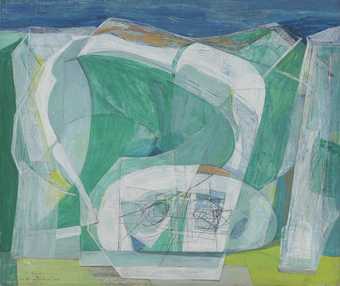
Wilhelmina Barns-Graham, Glacier Crystal, Grindelwald 1950. Tate. © Wilhelmina Barns-Graham Trust.
1940–1965
19 rooms in Walk Through British Art
This is a time of instability, social change and dramatic geopolitical realignments. Artists give visual expression to the traumas of loss, destruction and displacement
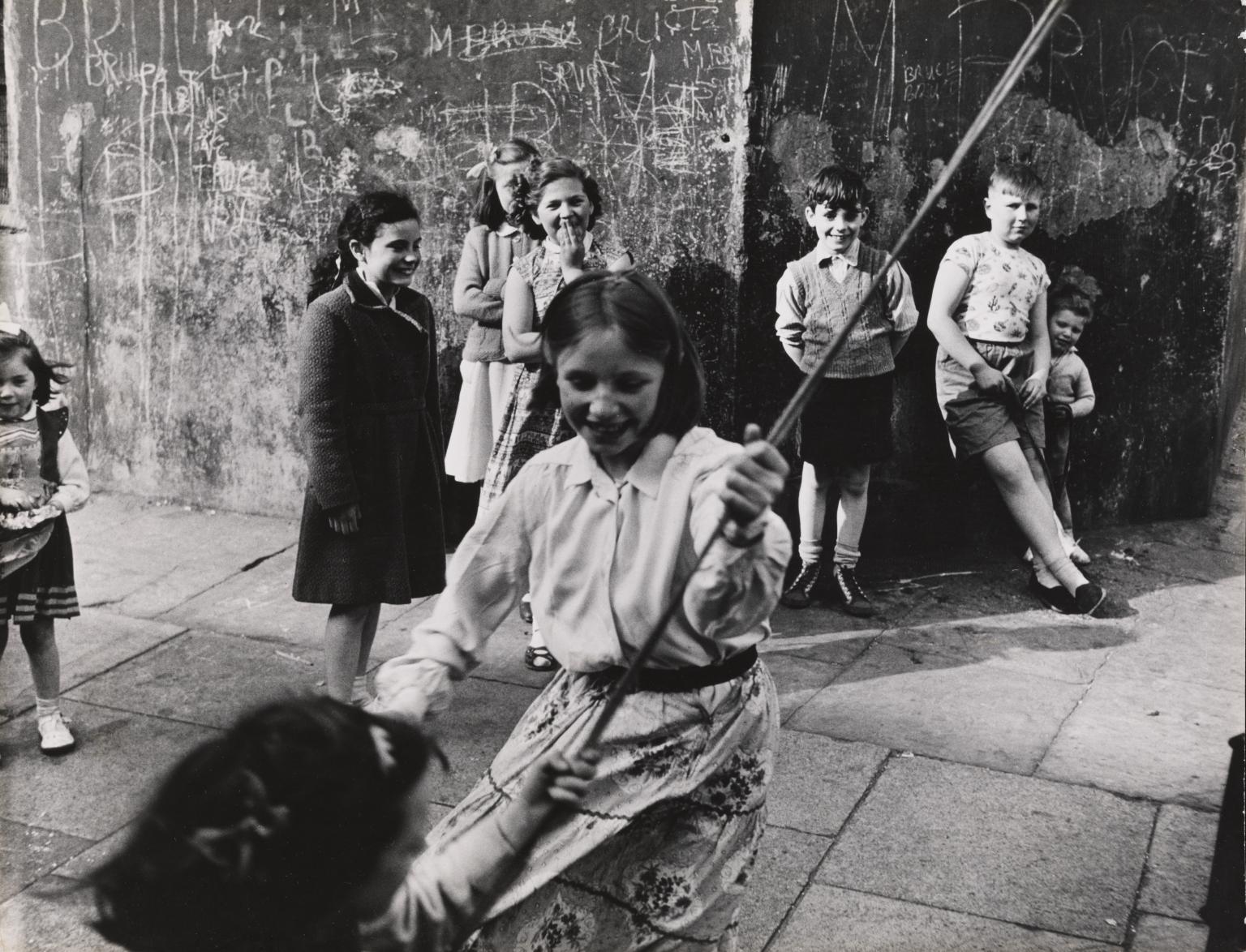
Roger Mayne, Girls swinging on a rope, Southam Street 1951
1/25
artworks in 1940–1965
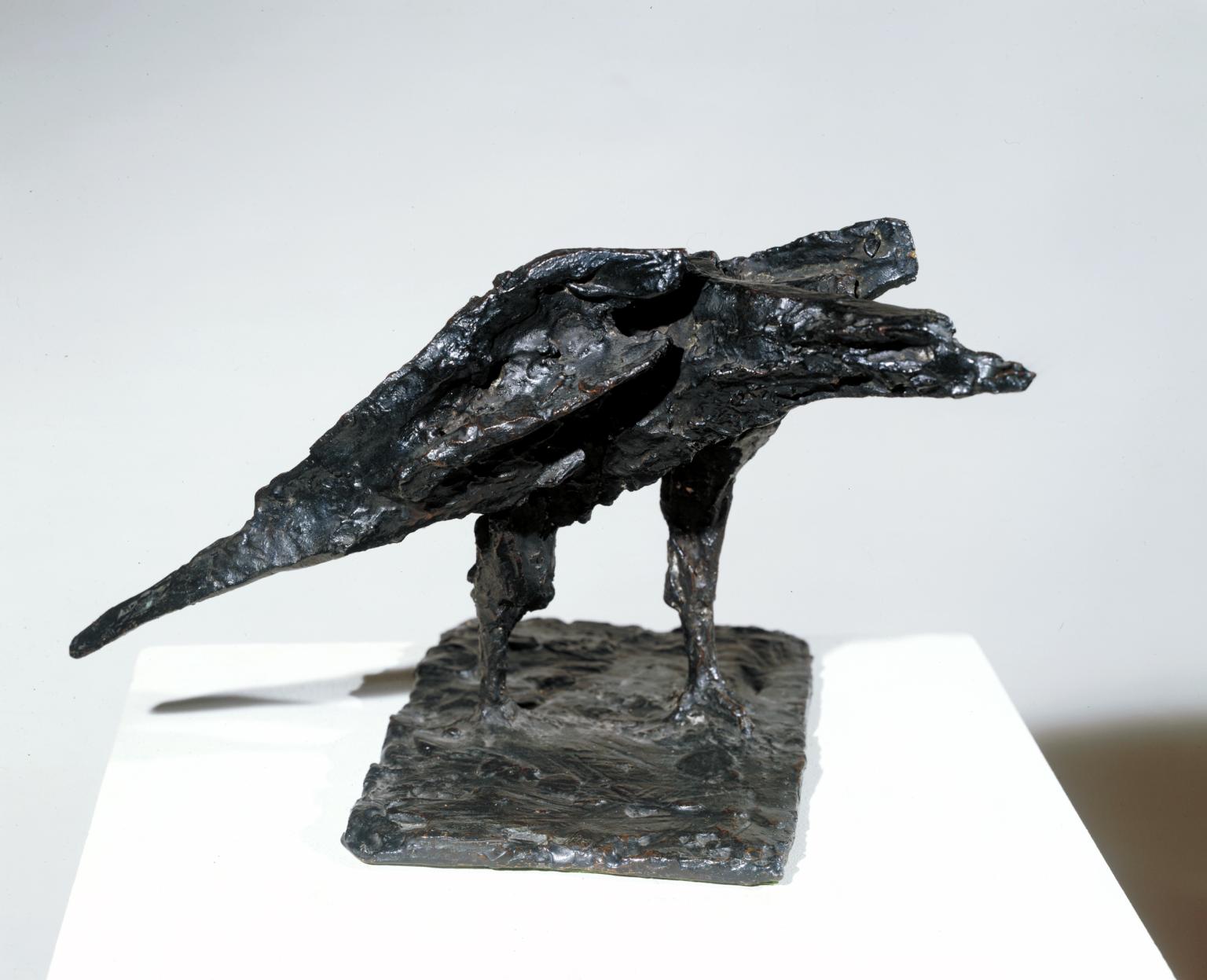
Dame Elisabeth Frink, Bird 1952
The prodigious Frink began to show her work in public in 1951 and among her first sculptures was this strong and alert bird, rather like a crow or a raven. The bird theme was to occupy Frink over the next two decades. Of these early sculptures she said that they ‘were really expressionist in feeling - in their emphasis on beak, claws and wings - and they were really vehicles for strong feelings of panic, tension, aggression and predatoriness. They were not, however, symbolic of anything else; they certainly were not surrogates for human beings or ‘states of being.’
Gallery label, September 2016
2/25
artworks in 1940–1965
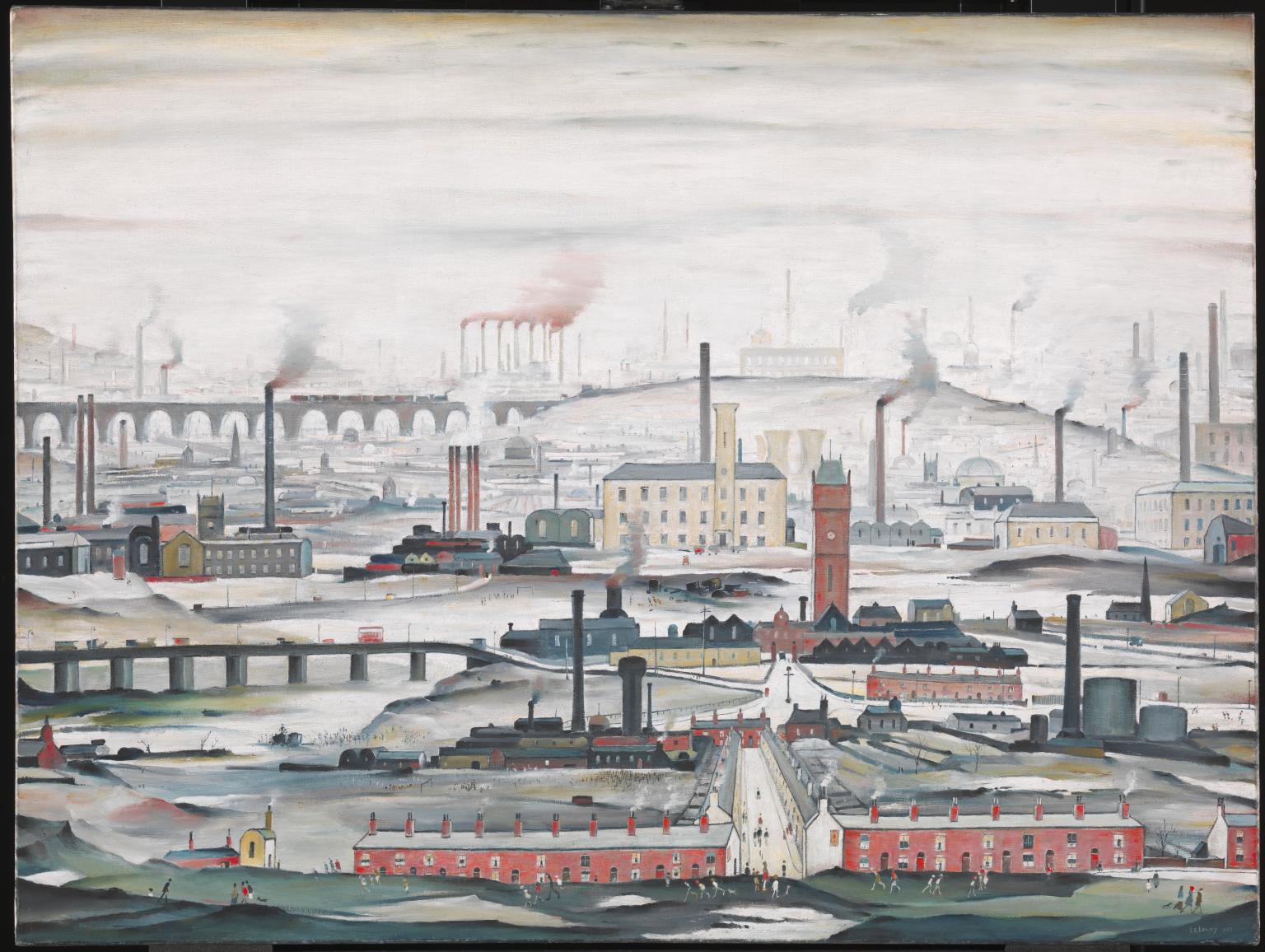
L.S. Lowry, Industrial Landscape 1955
This picture is typical of the panoramic cityscapes that Lowry painted throughout his career. Although it is an imaginary composition, elements of the view are recognisable as real places. For example, the Stockport Viaduct, which constantly haunted the artist, can be seen in the top left of the picture. But on the whole the image presents a generalised impression of the urban environment, dominated by smoking chimneys, factories, roads, bridges and industrial wasteland. As if to emphasise the human presence in this overwhelming, blackened city, Lowry focuses in on a small street in the foreground, almost inviting the viewer
to join the small group of people going about their business.
Gallery label, September 2004
3/25
artworks in 1940–1965
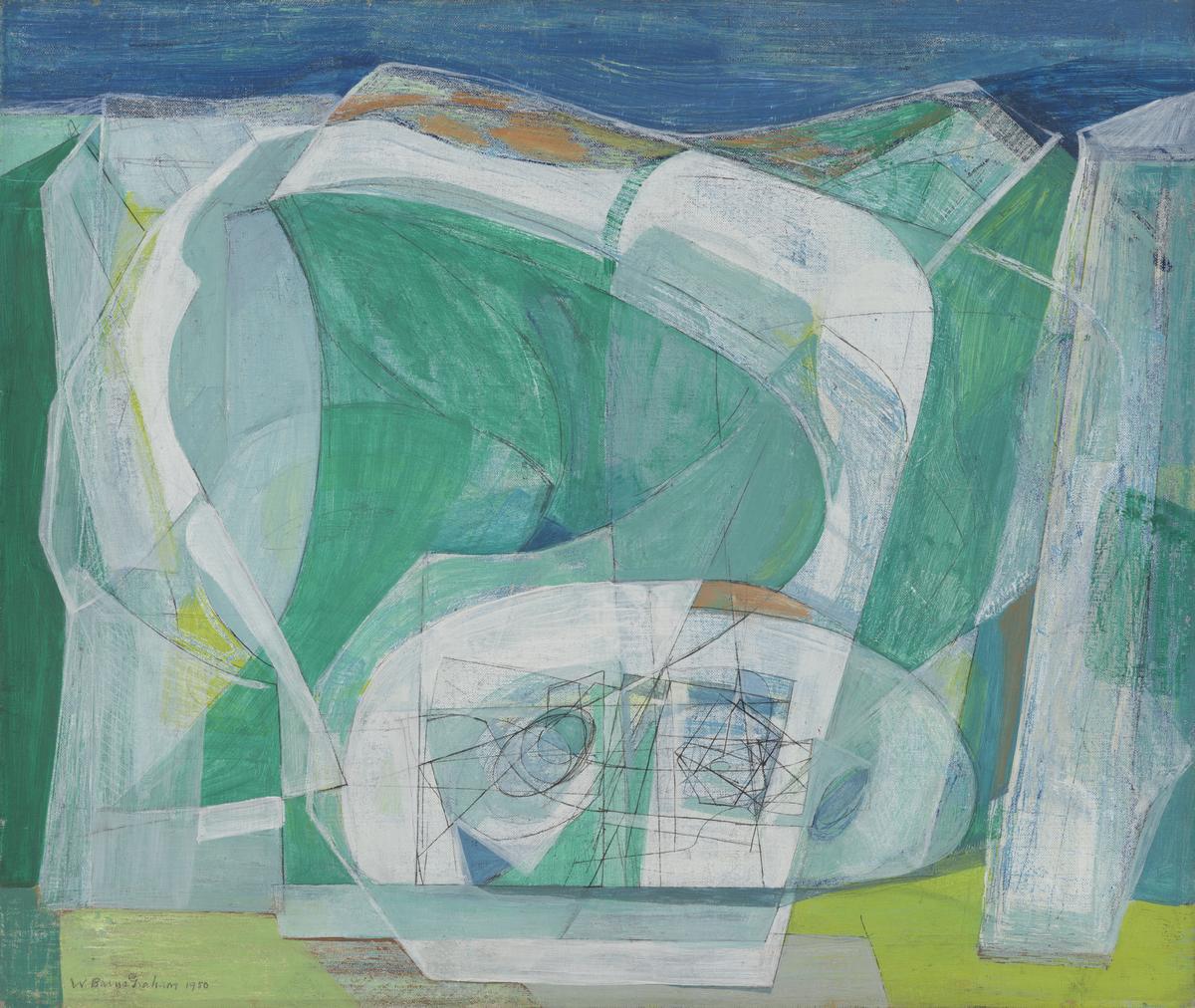
Wilhelmina Barns-Graham, Glacier Crystal, Grindelwald 1950
Barns-Graham lived in St Ives and her art combined natural subjects with the influence of older abstract artists Ben Nicholson and Naum Gabo. This is one of several works painted following a visit to the Grindelwald Glacier in Switzerland in 1948 where she had direct experience of the monumental shape of the glacier, its light, and the contrast between solidity and glass-like transparency. This led her to attempt to combine multiple views ‘from above, through and all round, as a bird flies, a total experience’.
Gallery label, September 2016
4/25
artworks in 1940–1965
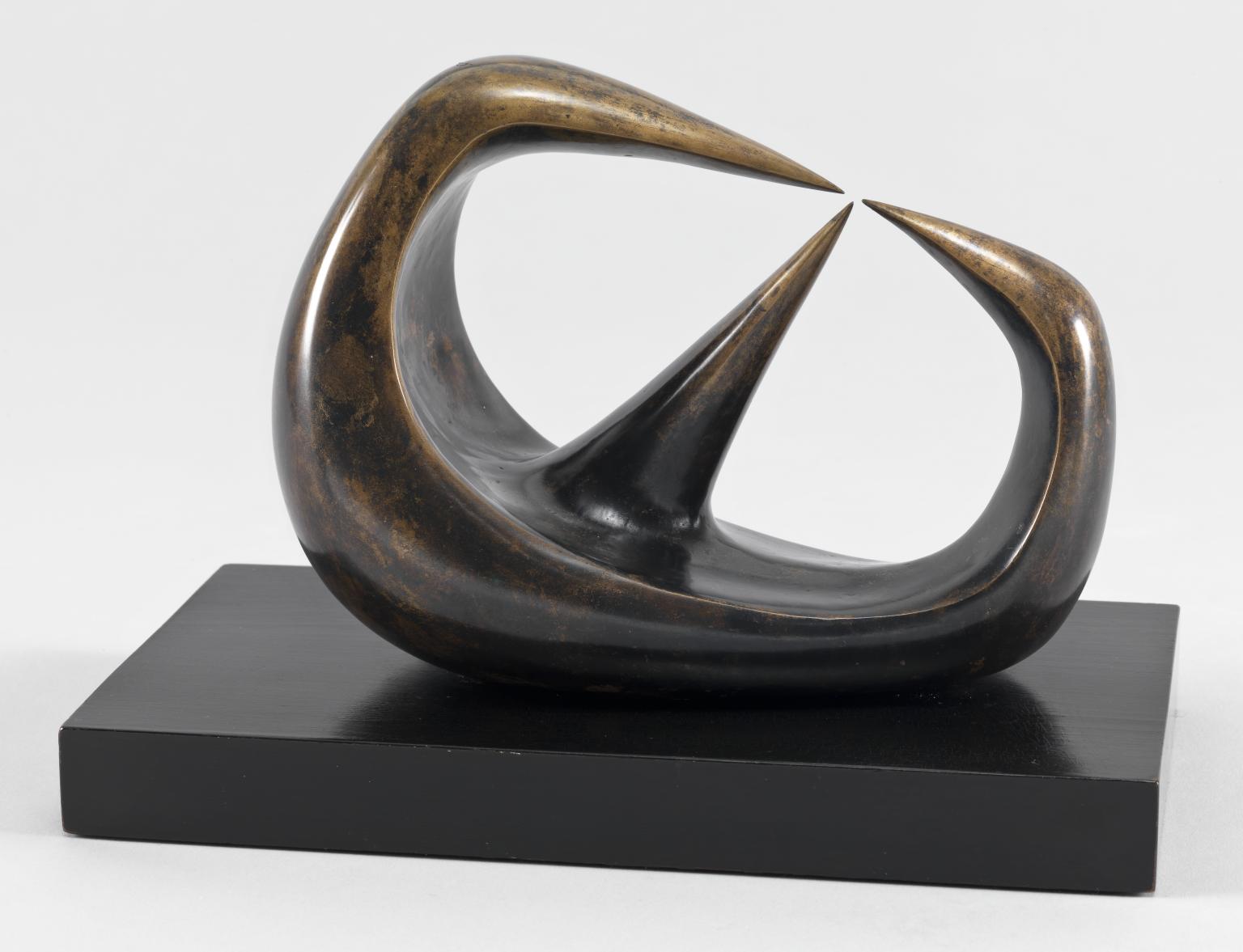
Henry Moore OM, CH, Three Points 1939–40, cast before 1949
Moore kept up with the activities of the Surrealist’s in Paris. He also contributed to the International Surrealist Exhibition in London. Several of his works explore feelings of uncertainty and anxiety that relate to Surrealism. The use of space in Three Points creates a sense of anticipation. Moore commented: ‘This pointing has an emotional or physical action in it where things are just about to touch but don’t... like the points in the sparking plug of a car... the spark has to jump across the gap’.
Gallery label, June 2021
5/25
artworks in 1940–1965
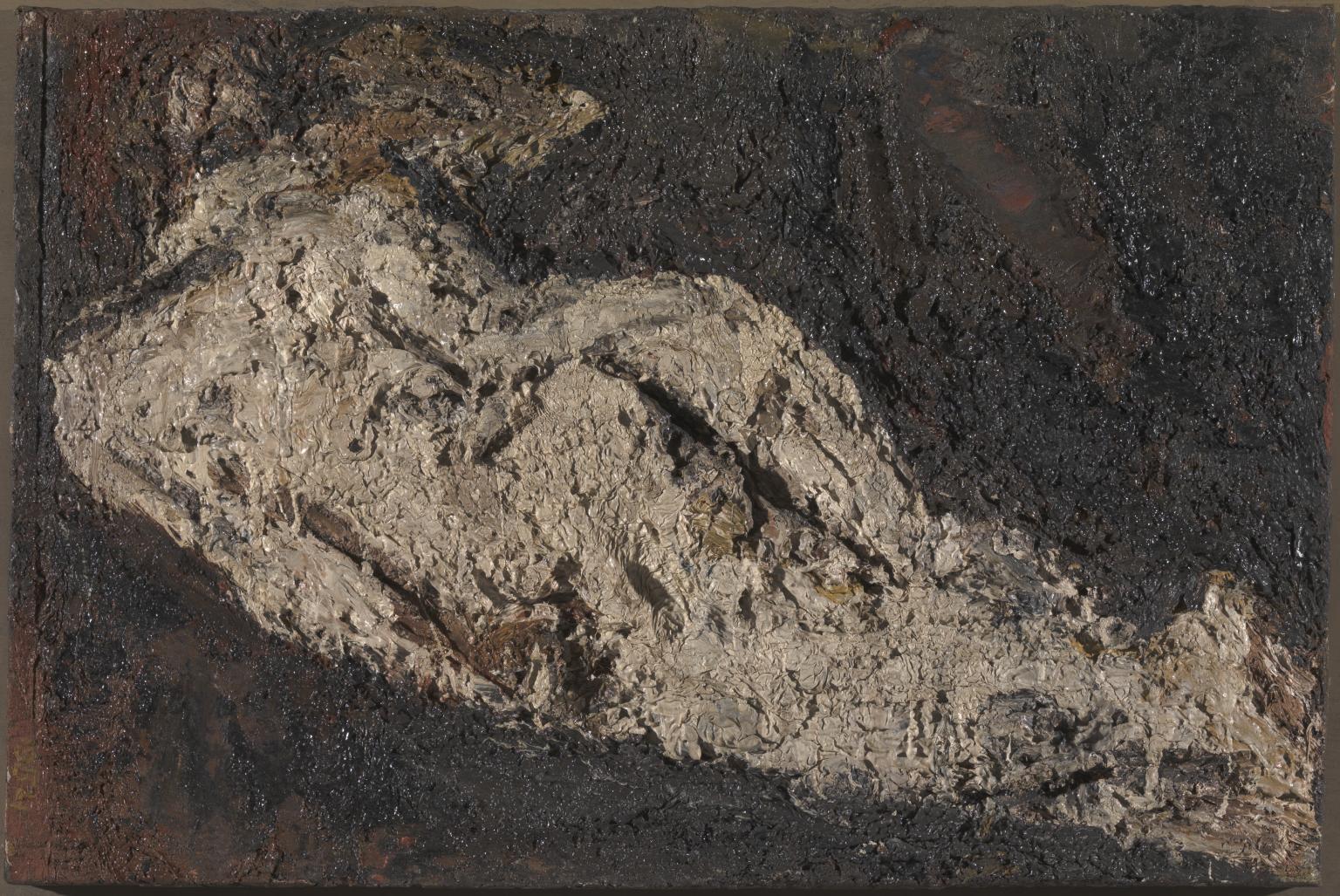
Frank Auerbach, E.O.W. Nude 1953–4
Auerbach studied with Bomberg longer than anyone else. He started at Borough Polytechnic in January 1947 and went to evening classes there until 1953, while officially attending St Martin’s School of Art and the Royal College of Art.
Auerbach said he learnt from Bomberg not technique but ‘a sense of the grand standards of painting.’ He developed a distinctive manner of painting in which thick paint is given an independent reality of its own, as well as being used as a means of representing a physical object.
Gallery label, September 2004
6/25
artworks in 1940–1965
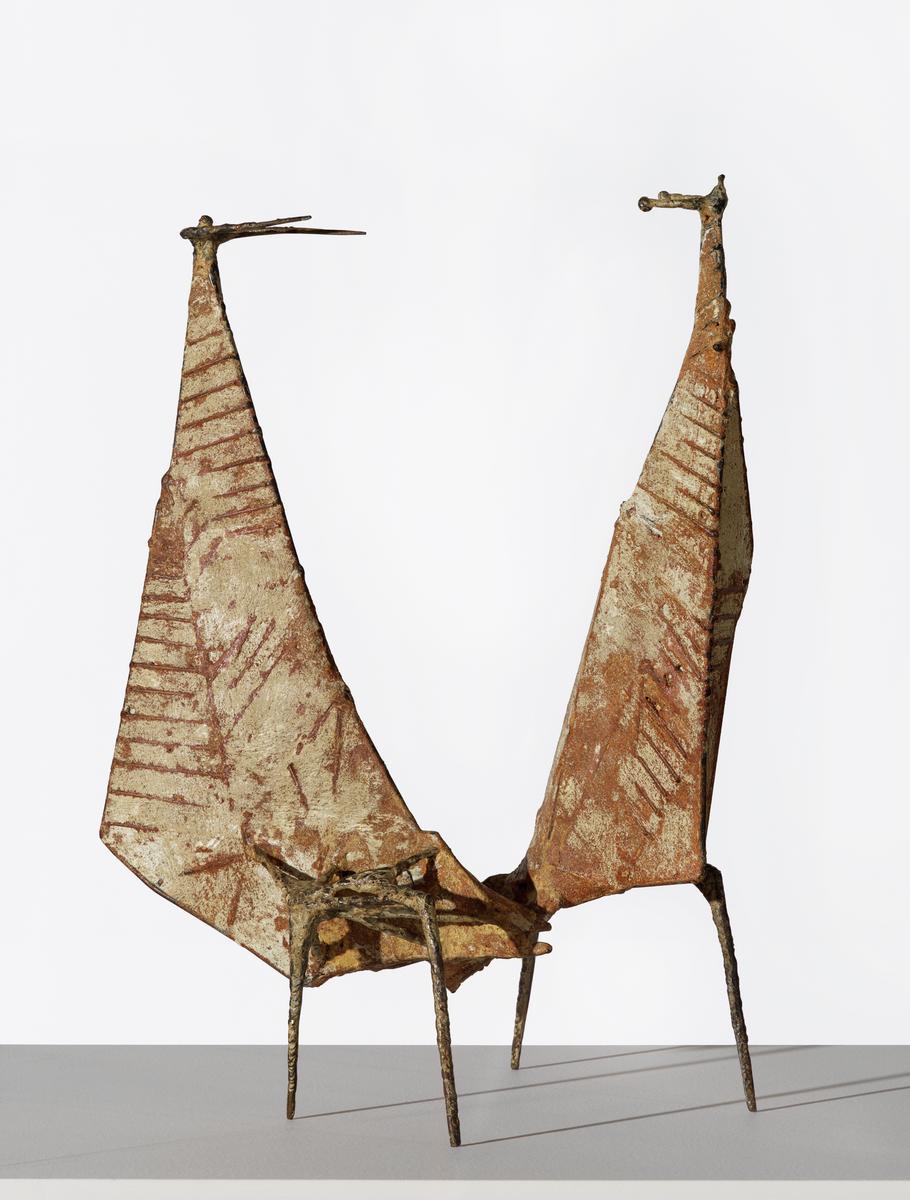
Lynn Chadwick, Conjunction 1953
Chadwick was one of the leading sculptors of the twentieth century. He trained at the Merchant Taylors’ School and worked as an architectural draughtsman before becoming an artist. In 1956 he gained international recognition when he won the International Prize for Sculpture at the Venice Biennale. He was awarded the CBE in 1964.
Conjunction is one of Chadwick’s first sculptures of a human couple. It has powdered iron on its surface which has since rusted. This gives the sculpture its distinctive colour.
Gallery label, August 2004
7/25
artworks in 1940–1965
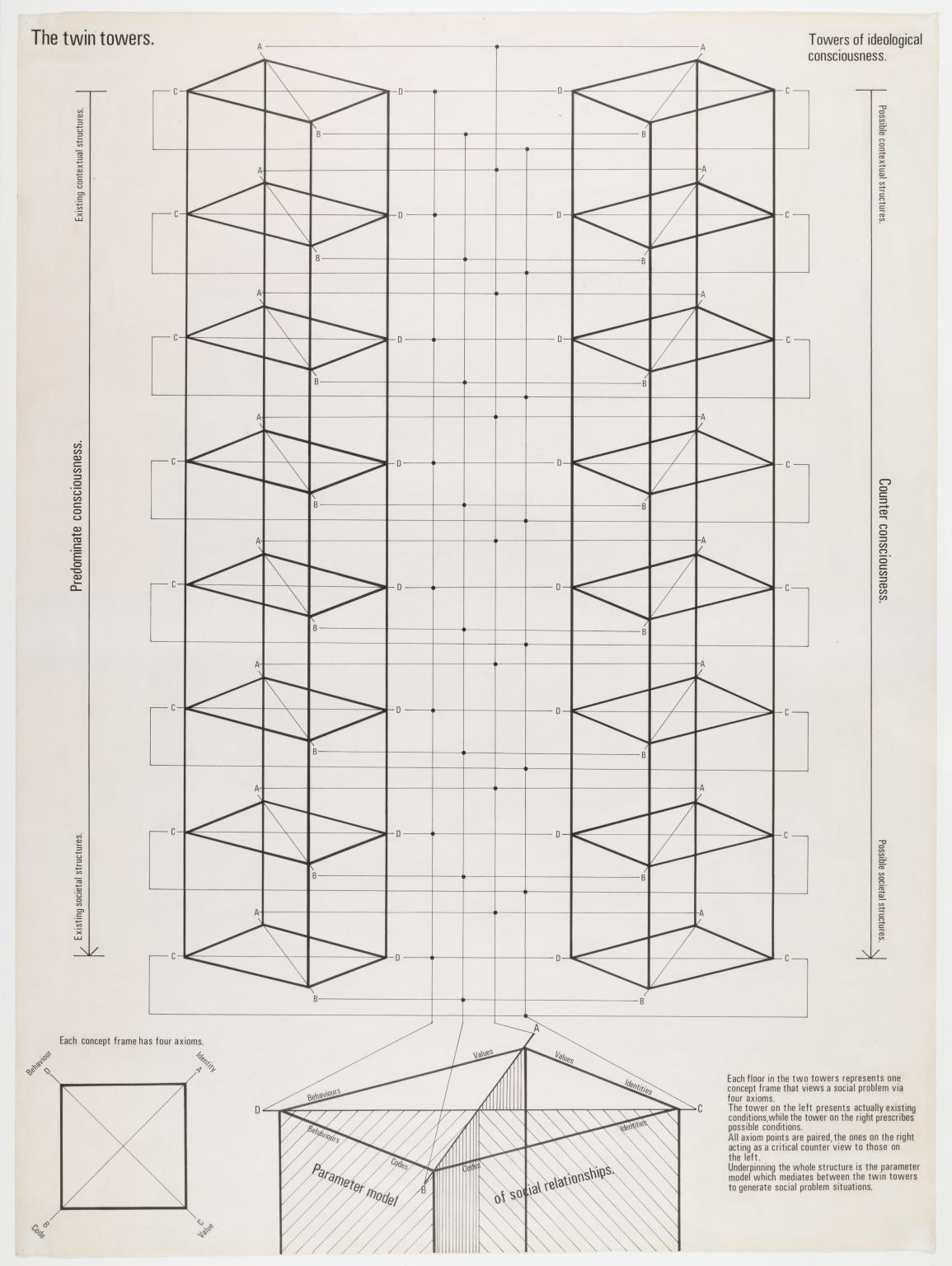
Stephen Willats, The Twin Towers 1977
The Twin Towers 1977 is a drawing in ink with Letraset on paper. It consists of a schematic volumetric rendering of two minimalistic rectangular towers side by side, named by the artist ‘Towers of Ideological Consciousness’. Letraset has been used to label different parts of the diagram. Each tower is divided equally by ‘floors’ that represent a particular ‘concept frame’ of relationships. Points of contact and parallel existences are charted between the two towers. The two ‘ideological consciousnesses’ which the towers embody are described as a ‘predominate consciousness’ and a ‘counter consciousness’. Each concept frame is subject to the four axioms of code, behaviour, identity and value and the combination of these axioms provides Willats with his ‘Parameter Model of Social Relationships’, which appears at the bottom of the drawing and through which combinations of frame and context may be deployed. In a text at the bottom right of the drawing, Willats explained:
8/25
artworks in 1940–1965
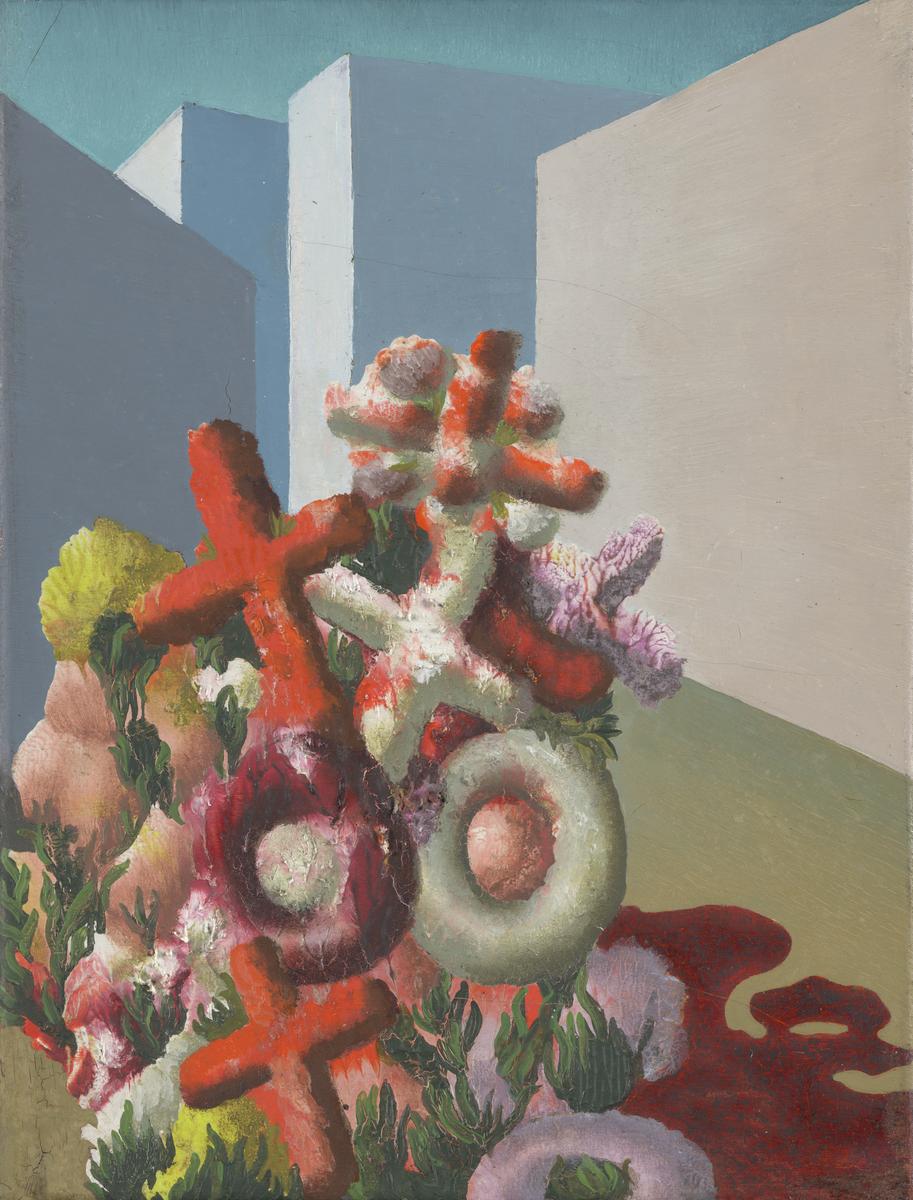
Ithell Colquhoun, E.L.A.S. 1945
9/25
artworks in 1940–1965
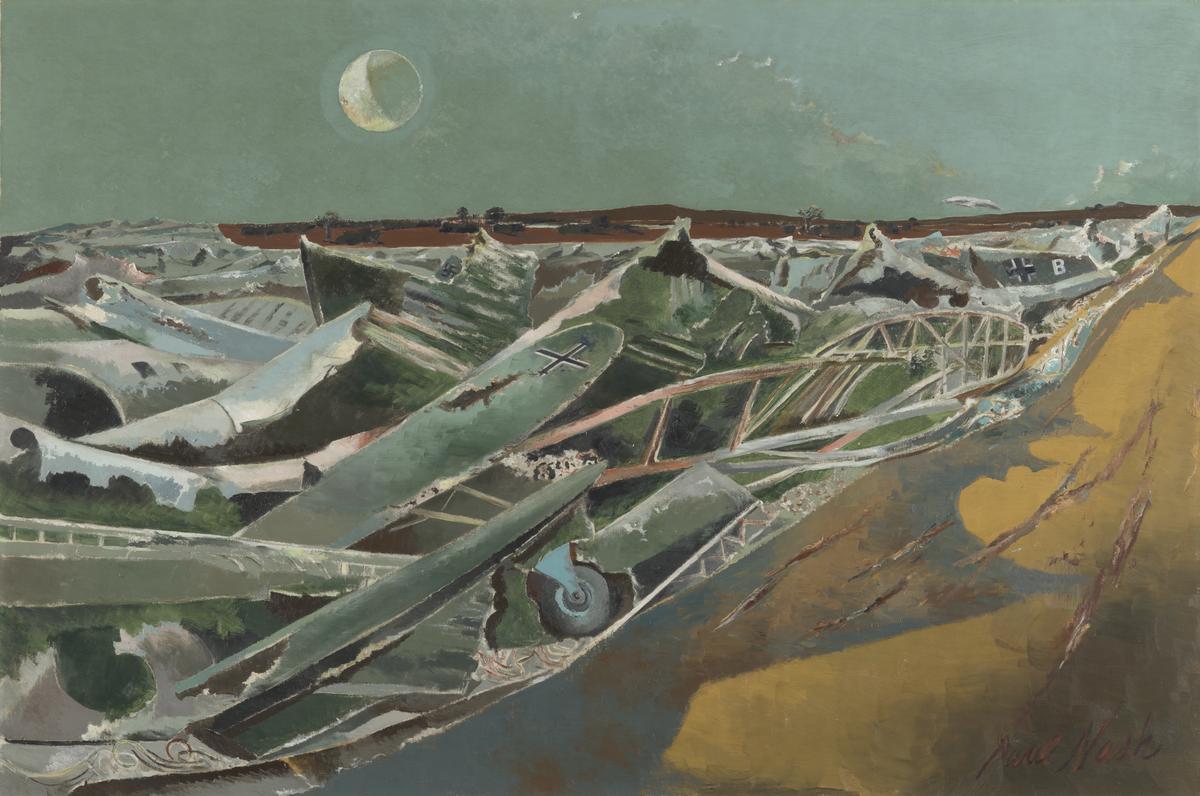
Paul Nash, Totes Meer (Dead Sea) 1940–1
This painting, the title of which is German for ‘dead sea’, was made during the first half of the Second World War. It was inspired by a wrecked aircraft dump at Cowley in Oxfordshire. Nash based the image on photographs he took there. The artist described the sight: ‘The thing looked to me suddenly, like a great inundating sea ... the breakers rearing up and crashing on the plain. … nothing moves, it is not water or even ice, it is something static and dead.’ He created an unsettling atmosphere by setting the scene at night and including a solitary owl in flight.
Gallery label, April 2019
10/25
artworks in 1940–1965
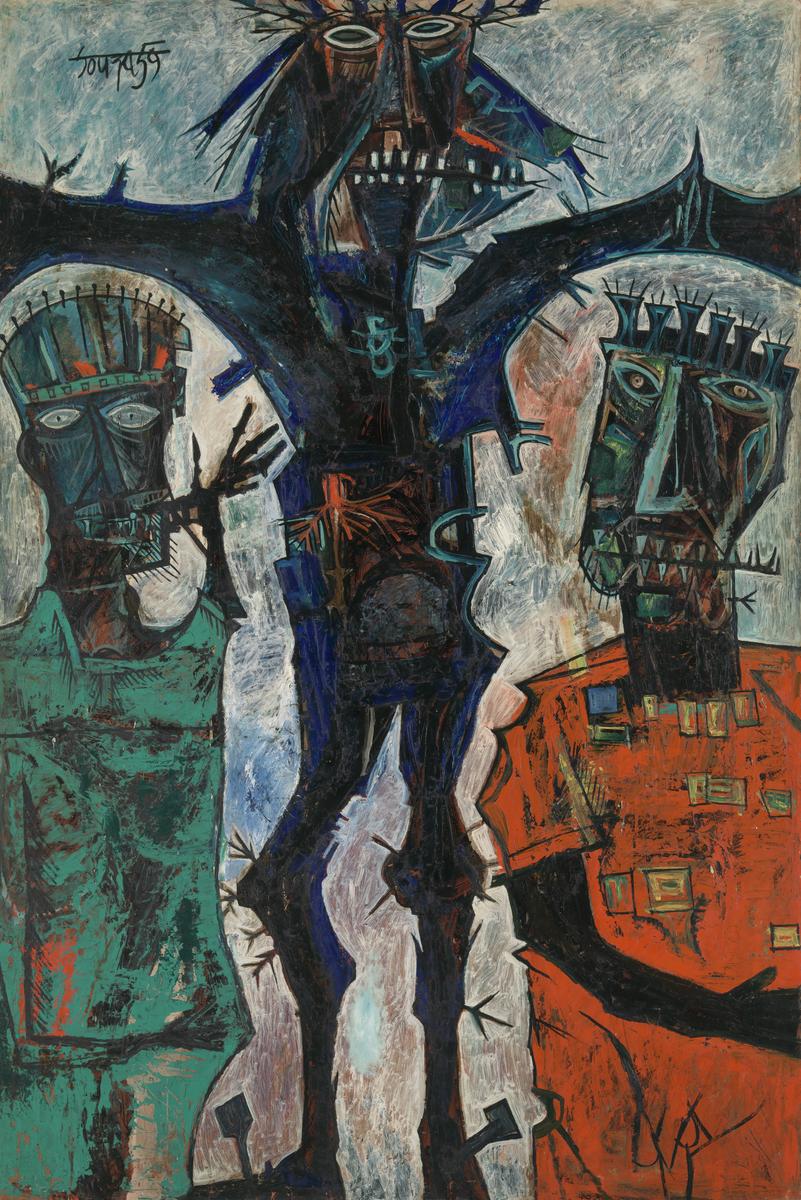
F.N. Souza, Crucifixion 1959
At the heart of Souza’s Crucifixion is the body of Christ transformed through suffering. Souza was born in the Catholic province of Goa in western India. In the 1950s, he was among the first of the post-Independence generation of Indian artists to establish a career in Britain. His depiction of the agonised black Christ addresses his own feelings of religious conflict, as well as cultural tensions between black and white, Christian and non-Christian, colonised and colonising societies.
Gallery label, September 2016
11/25
artworks in 1940–1965
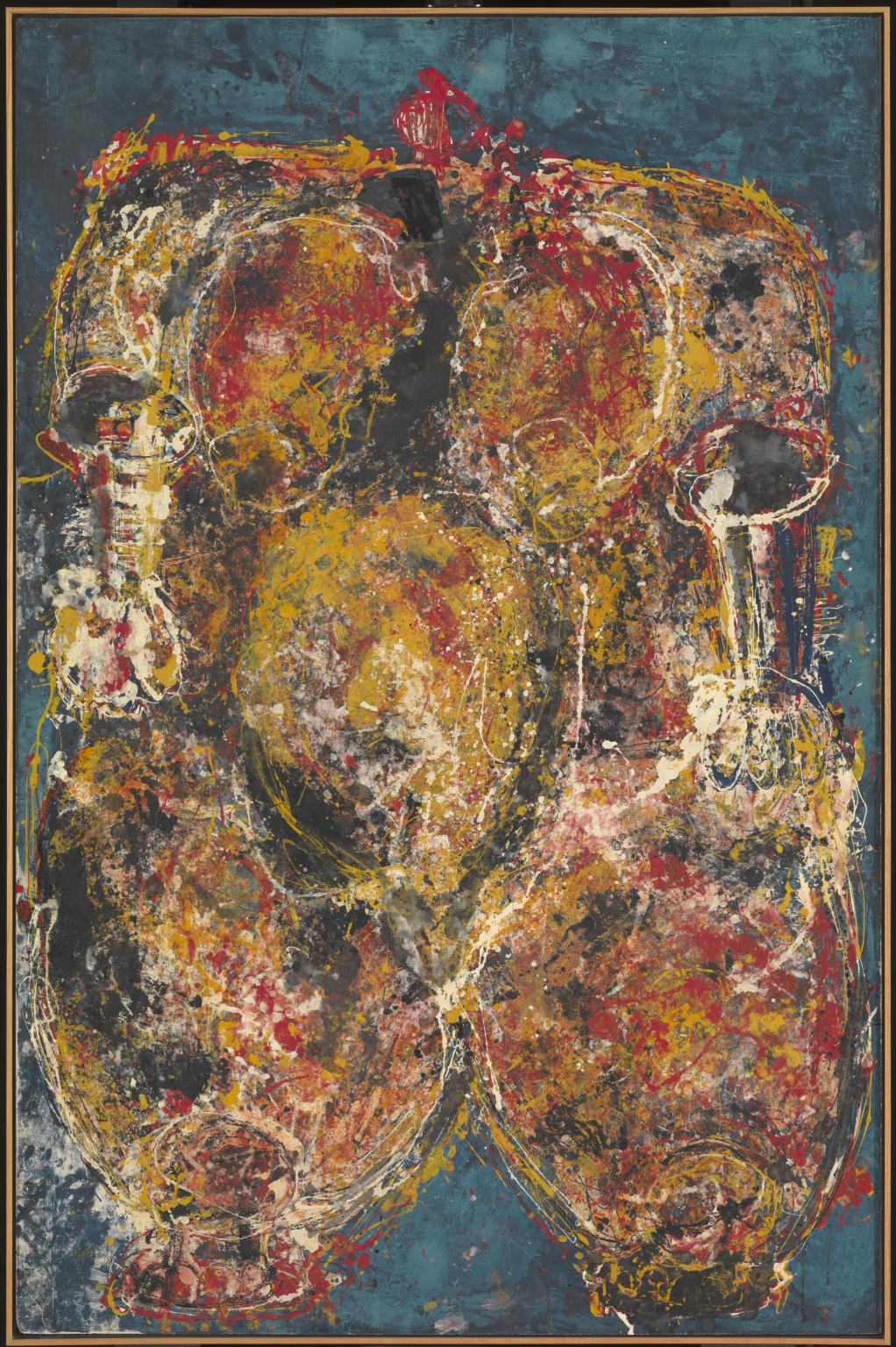
Magda Cordell, Figure (Woman) 1956–7
With its highly textured surface and sack-like body, Cordell’s Figure (Woman) shows an affinity with the expressive abstraction of European artists such as Jean Dubuffet and Jean Fautrier. Her depiction of the female figure was seen by contemporary critics as a break with traditional representations of women, embodying the anxieties of a nuclear age. More recently, her paintings have been seen as images of heroic femininity with the distortions signifying the resilience of the human body against injury and change.
Gallery label, October 2016
12/25
artworks in 1940–1965
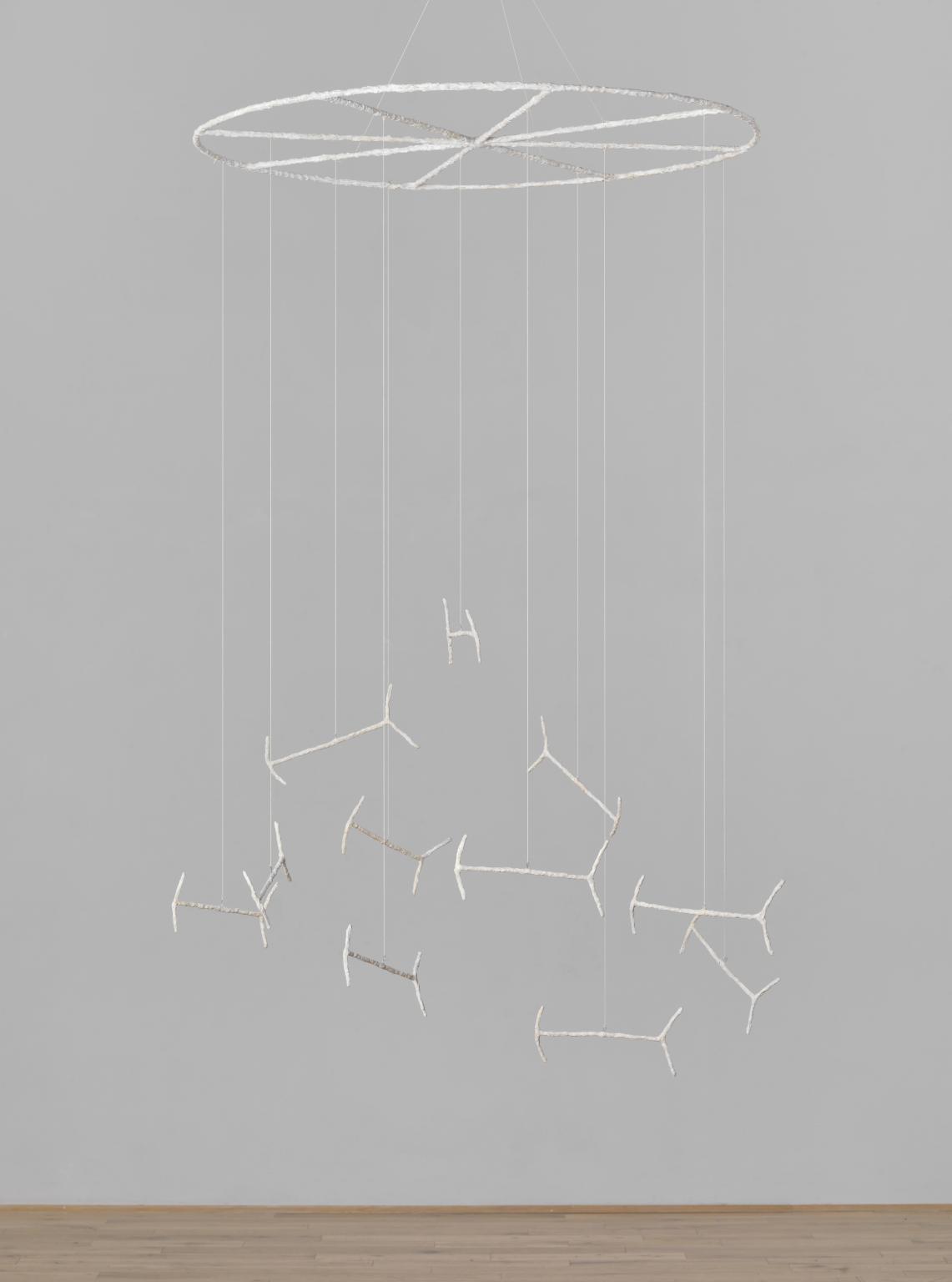
William Turnbull, Hanging Sculpture 1949
13/25
artworks in 1940–1965
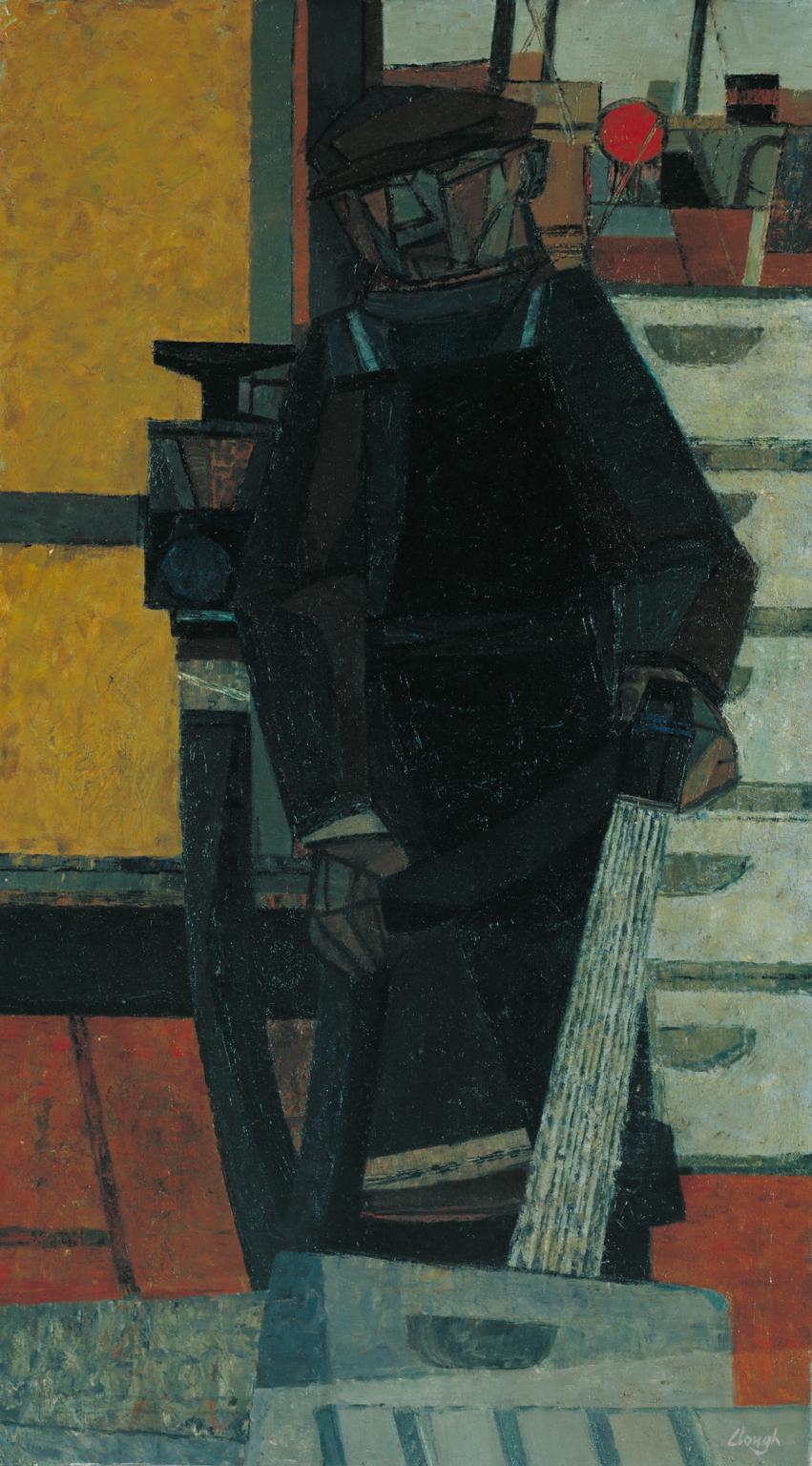
Prunella Clough, Man Hosing Metal Fish Boxes 1951
In the late 1940s and early 1950s the ‘common man’ or labourer was a dominant subject for Clough and some of her contemporaries. During the years 1946 to 1949 Clough often visited the coast of East Anglia and this subject is thought to stem from her time there. Although inspired by a certain locality, Clough’s work usually turns the particular and localised into something more universal. She gives a sense of monumentality to the figure occupied in a menial task, while also suggesting the gritty realism of the life of the working man.
Gallery label, September 2016
14/25
artworks in 1940–1965
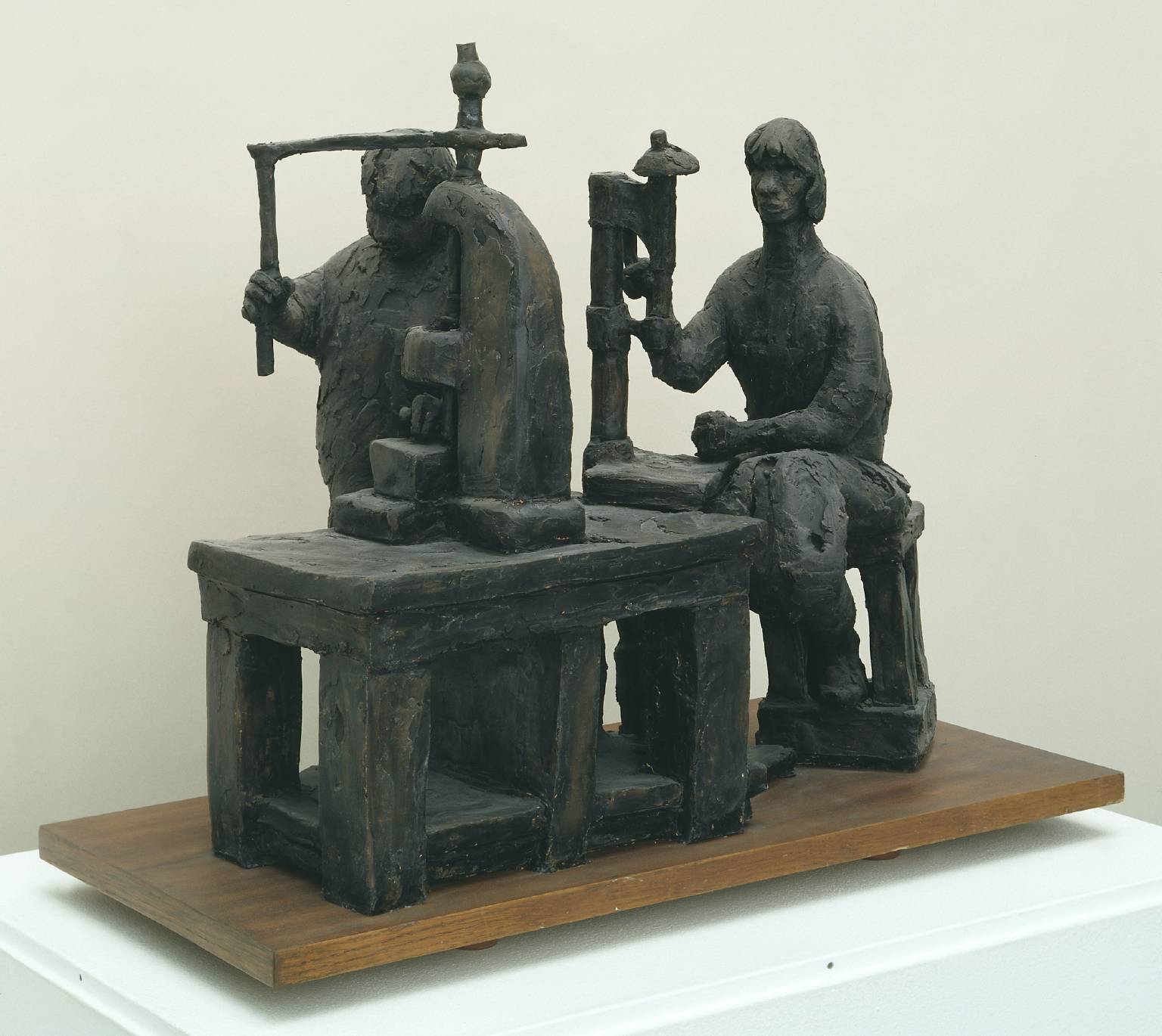
Ghisha Koenig, Metal Punchers I 1957
Koenig was interested in the lives of the working class and from the mid-1950s onwards she regularly sketched people working in factories. These drawings were the source material for her sculptures which capture people in all their physical diversity, performing their allotted tasks with varying degrees of enthusiasm. As such they were not idealised visions of the dignity of labour but purported to be truthful records of factory life.
Gallery label, August 2019
15/25
artworks in 1940–1965
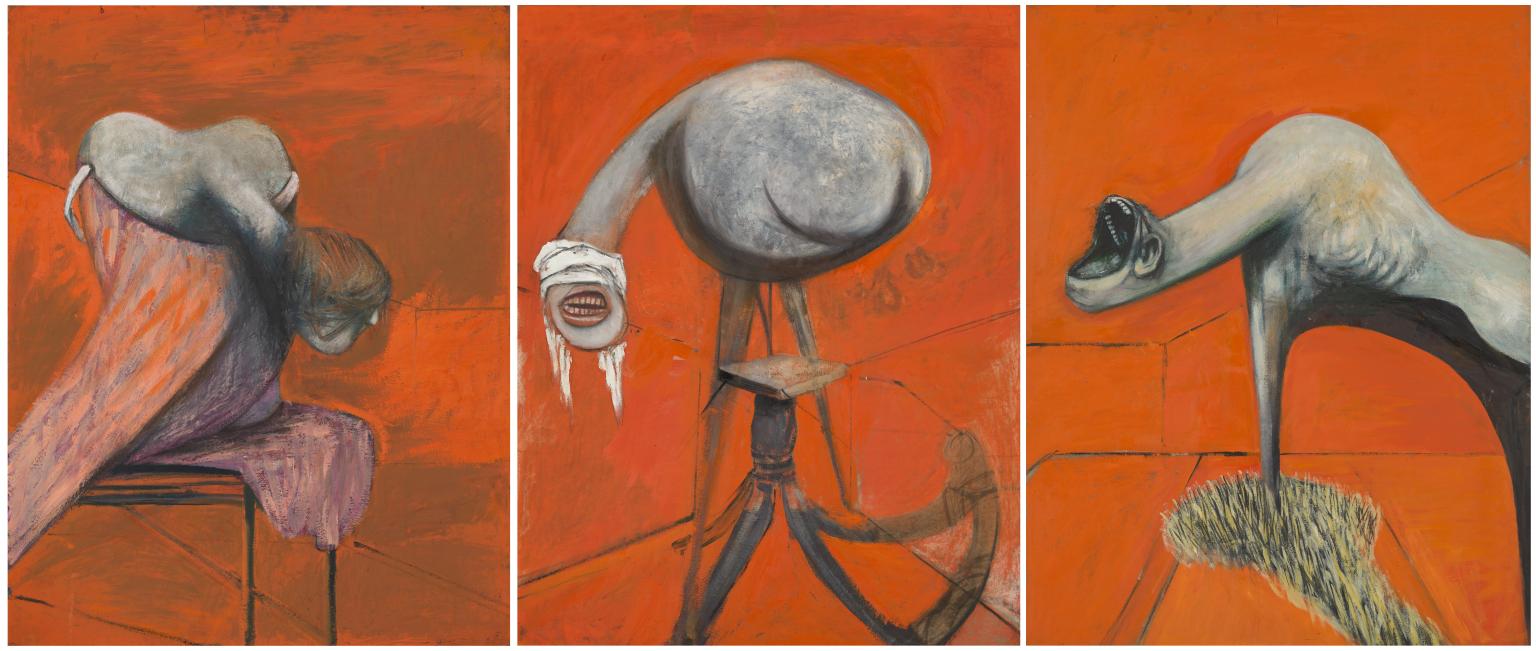
Francis Bacon, Three Studies for Figures at the Base of a Crucifixion 1944
The title of this work refers to figures that are often featured in Christian paintings of the death of Jesus. Bacon said the figures in his work represented the Furies, ancient Greek goddesses. They punished human wrongdoing. The work was first shown publicly in April 1945. The Second World War was in its final months, after six years of conflict. The first photographs and film footage of Nazi concentration camps were being released. For some, Bacon’s painting reflected the horror of the Holocaust, in which six million Jewish people were murdered. It was also seen to reflect the fear caused by the development of nuclear weapons.
Gallery label, July 2020
16/25
artworks in 1940–1965
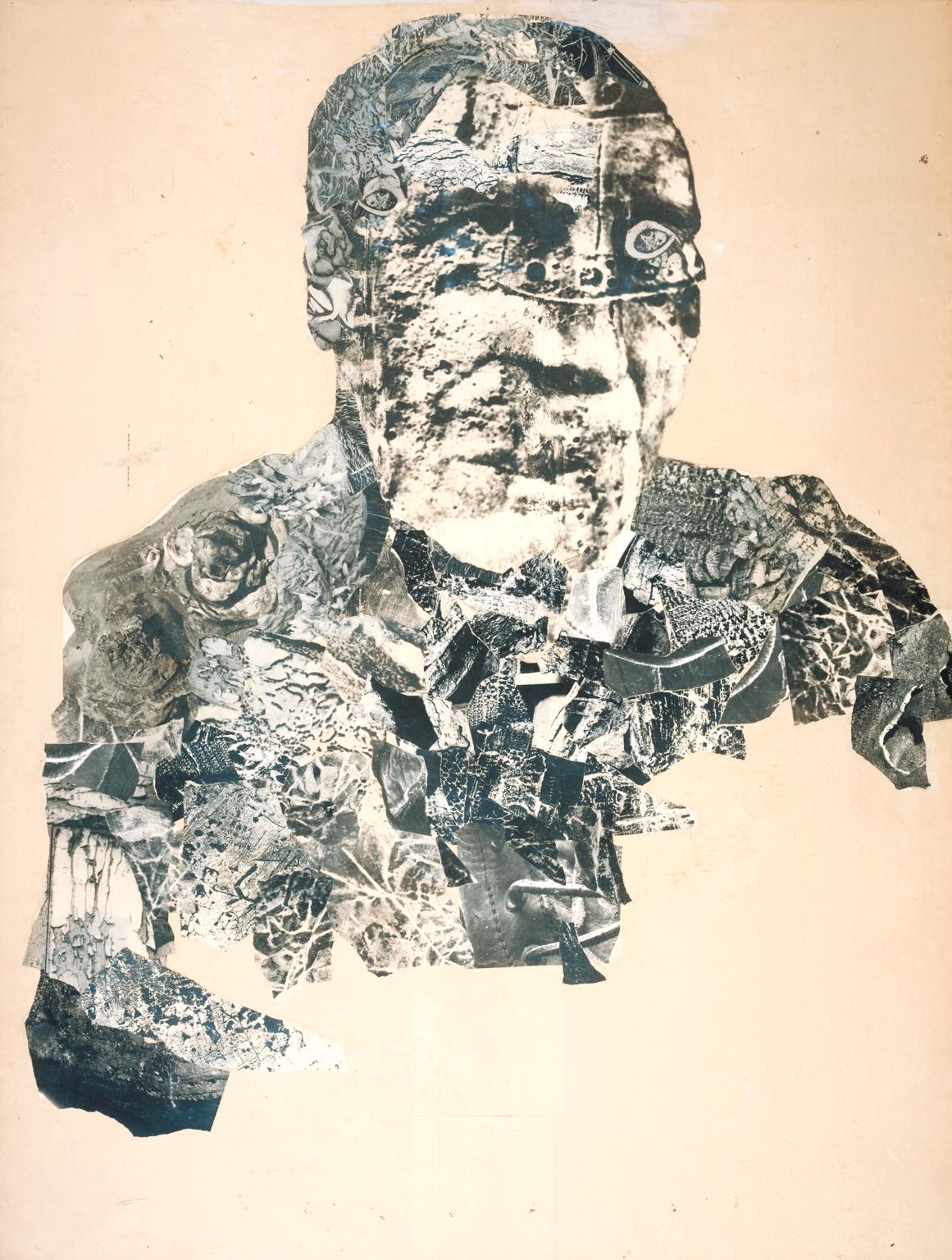
Nigel Henderson, Head of a Man 1956
Head of a Man is made from roughly layered photographs of vegetables, charred logs, stones, leaves, a shoe and a scratched wall. Henderson described the work as ‘Out of Nature and into Industry’. He began by making a smaller collage, which he photographed and enlarged. He then added more photographic cuttings and paint. Finally, he re-photographed and further enlarged the work to create this densely layered image. It was originally exhibited as part of the collaborative installation, Patio and Pavilion, in 1956.
Gallery label, December 2019
17/25
artworks in 1940–1965
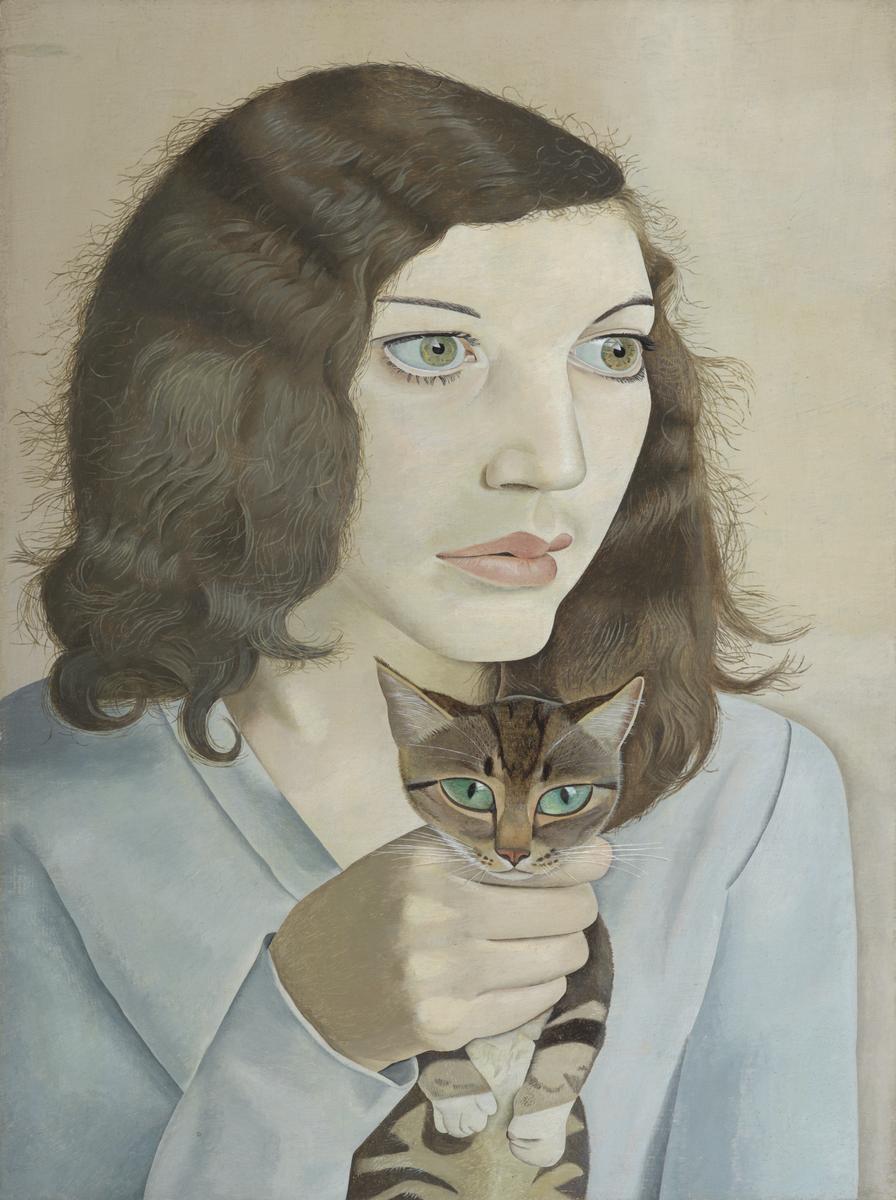
Lucian Freud, Girl with a Kitten 1947
In 1947 Lucian Freud fell in love with Kitty Garman, daughter of Kathleen Garman and Jacob Epstein, and the subject of eight portraits by Freud that chart their short marriage. In this closely-cropped composition, the kitten - serving as a namesake for Garman - is gripped tightly by the neck as it stares straight ahead, while Garman averts her gaze. Girl with a Kitten shows the way that Freud sought to embody character, rather than just illustrate likeness, and to create a sense of dramatic tension.
Gallery label, September 2016
18/25
artworks in 1940–1965
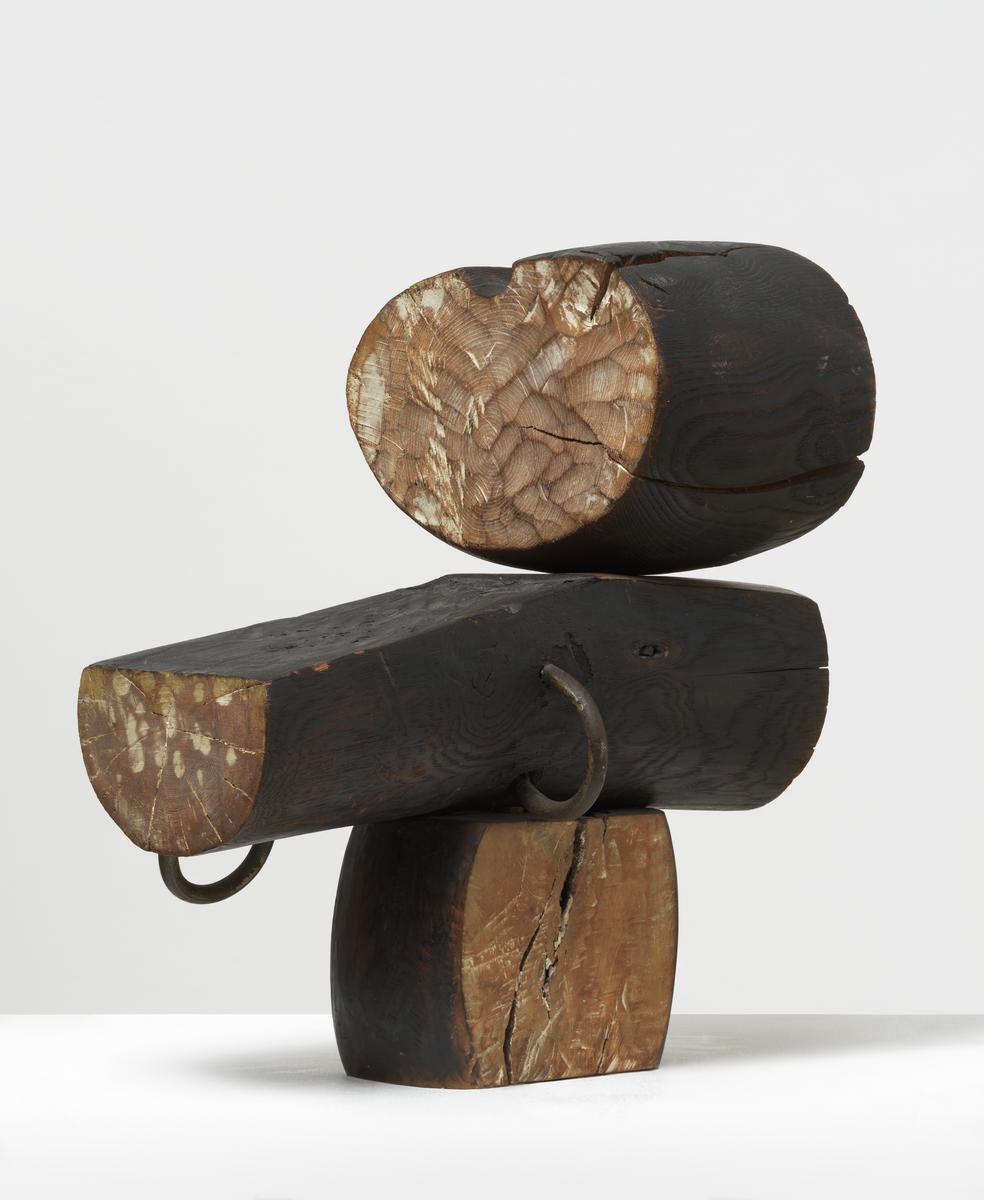
Kim Lim, Sphinx 1959
19/25
artworks in 1940–1965
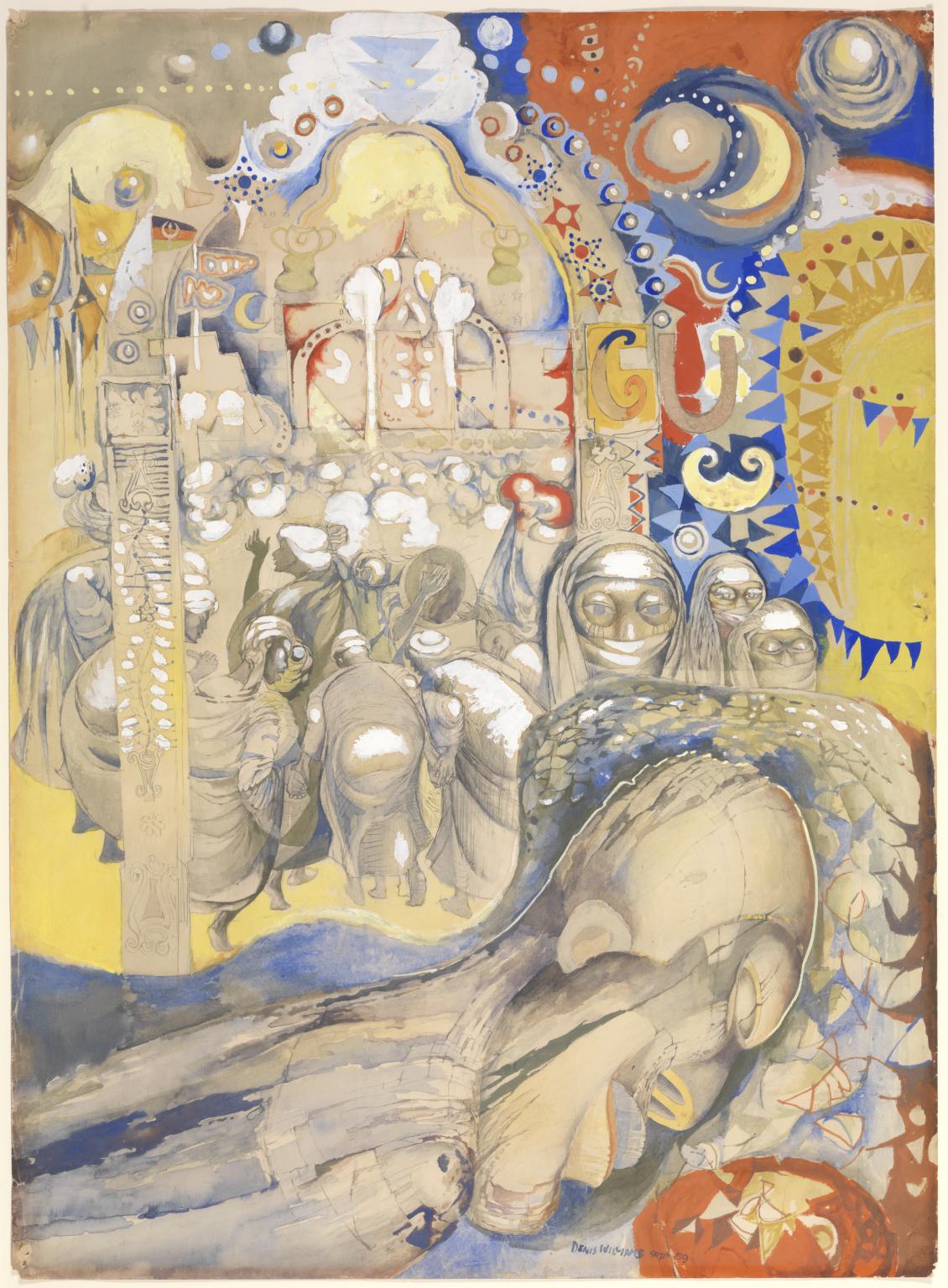
Denis Williams, Moulid el-Nabi 1959
This work on paper dating from 1959, realised in watercolour, ink, pencil and papier collé, represents a complex scene that combines abstraction and figuration. In the centre, a large Islamic archway, or ogee, frames a group of congregated men, draped and turbaned, bowing down before a number of performers, including a drummer and a figure seen in profile with raised hand. The form of the arch echoes that of an imposing building in the background, possibly a mosque with two minarets. The arch and the areas surrounding it at the top and sides of the composition are richly decorated with abstract motifs, predominantly painted in bright primary colours. The patterns, reminiscent of calligraphic ornamentation, include triangular and circular forms as well as patterns relating to celestial objects: stars, planets and crescent moons. On the right of the archway, excluded from the scene taking place in the background, is a group of three veiled women. Only the women’s heads are visible, as their bodies are obstructed by a large reclining torso and head of a male figure lying face-down in the foreground. This monolithic figure or sculpture appears buried beneath the cool blue of the earth’s surface. According to the artist’s daughter and biographer, Evelyn Williams, this painting provides the viewer with a unique and concrete reference to the artist’s recent engagement with archaeology in Sudan where he moved in 1957 (Williams 2012, p.74).
20/25
artworks in 1940–1965
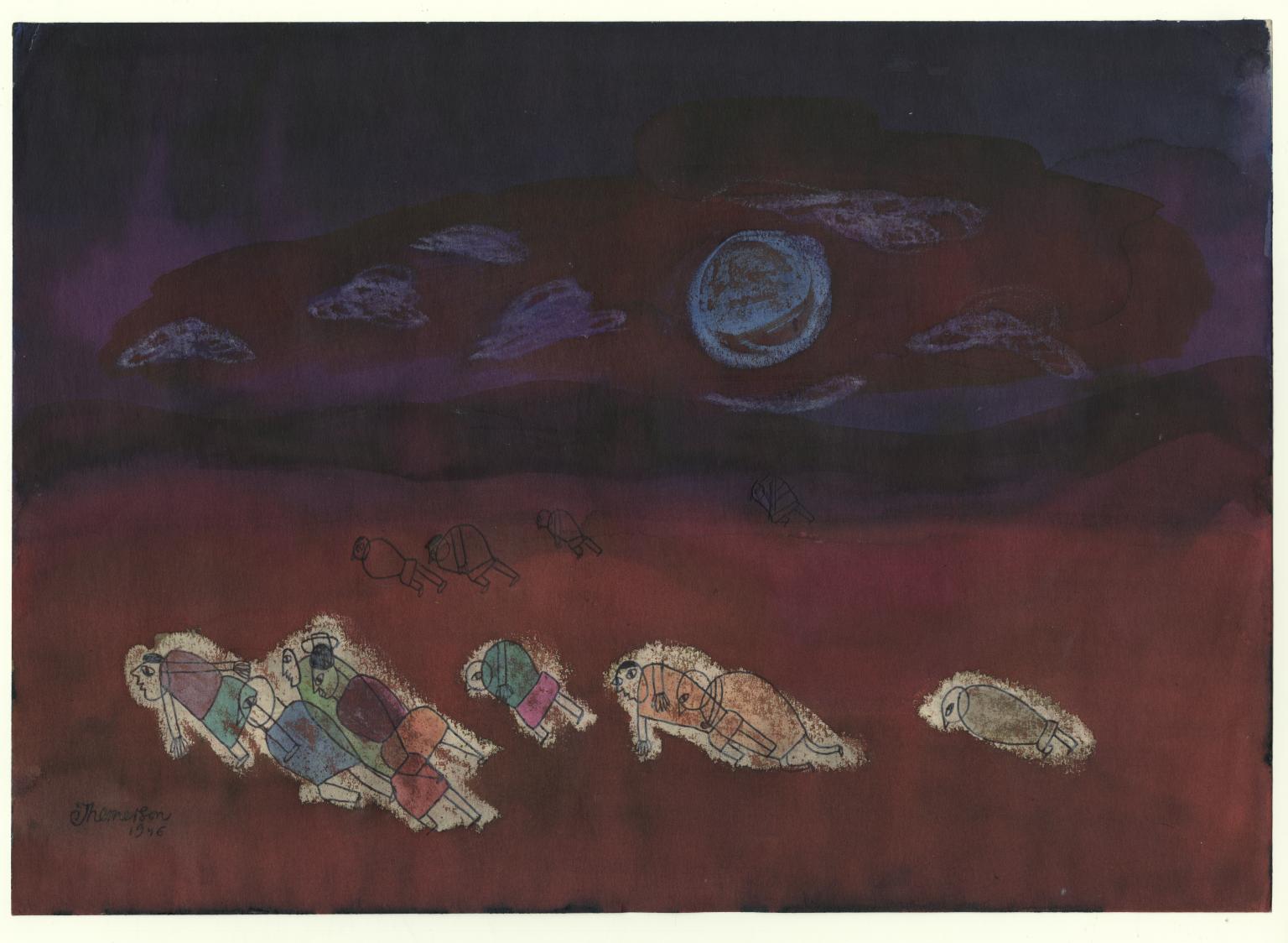
Franciszka Themerson, Struggling Figures in a Landscape 1946
This drawing belongs to a series of watercolours and gouaches begun in 1945. At the end of the Second World War, Franciszka Themerson had returned to making paintings. The series depicts townscapes, seashores and refugee figures. The bright colours are a new departure for the artist, but the subject matter continues to allude to the tragedies of the recent past.
Gallery label, October 2019
21/25
artworks in 1940–1965
Sorry, no image available
Roger Mayne, Group, St Stephen Gardens 1957
22/25
artworks in 1940–1965
Sorry, no image available
Roger Mayne, West Indians, Southam Street 1956, printed 1998
23/25
artworks in 1940–1965
Sorry, no image available
Peter Lanyon, St Just 1953
Lanyon named this painting for St Just-in- Penwith, the small, grey town that was the historic centre of the west Cornwall tin mining industry. Initially conceived as a crucifixion, Lanyon quickly associated this work with the tragic history of the mining district that runs west of St Ives towards St Just, as well as with mythological symbols of death and renewal. This painting was the culmination of a series of works made from late 1951 to 1954 in which Lanyon layered successive coats of thick paint in complex, tangled compositions that suggest landscapes with a symbolic meaning.
Gallery label, September 2016
24/25
artworks in 1940–1965
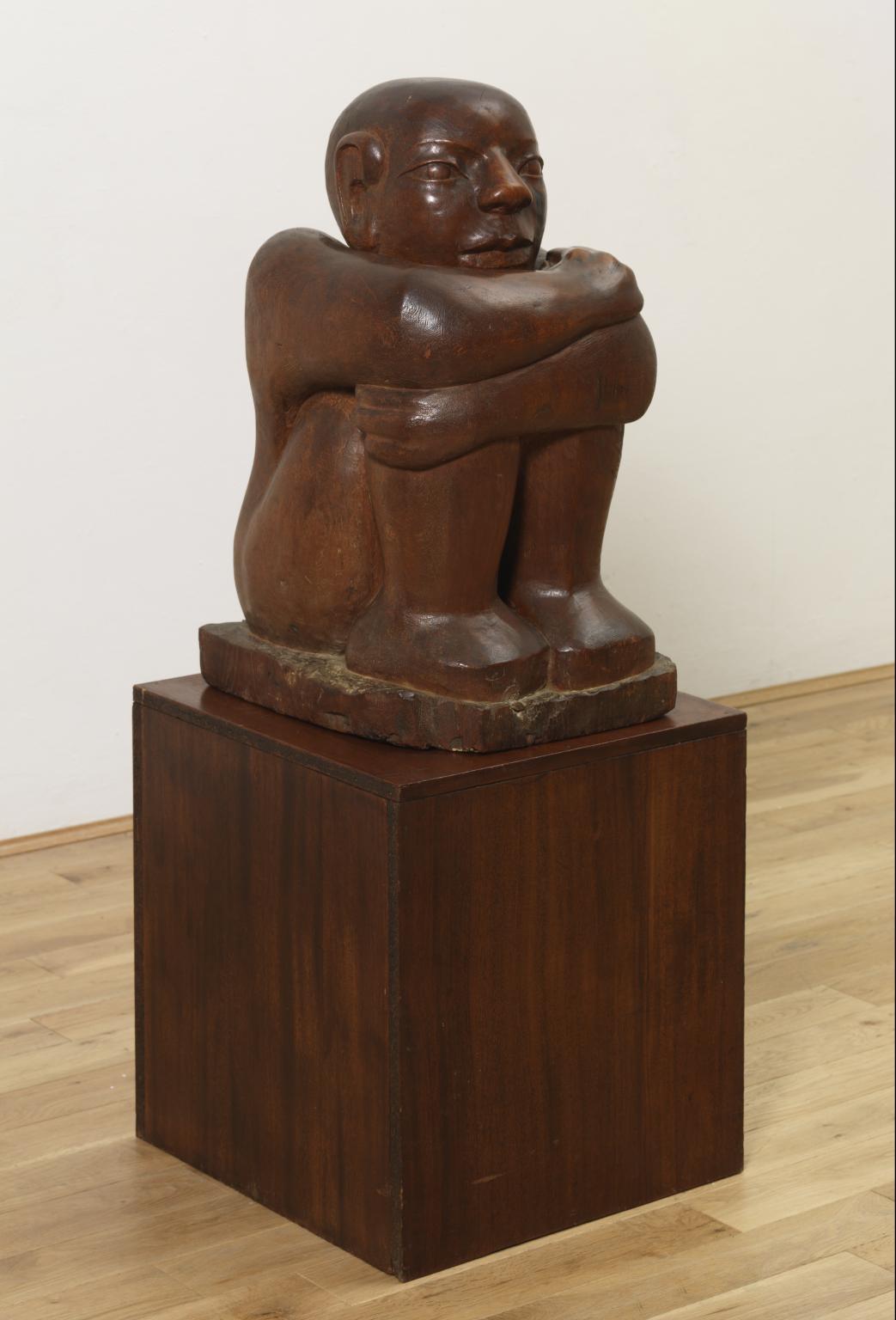
Ronald Moody, The Onlooker 1958–62
Moody moved to Paris in 1938, but was forced to flee in 1940, two days before it fell to Nazi occupation. He returned to Britain in 1941, where he remained until his death in 1984. In the 1950s and 1960s Moody exhibited regularly in London. The Onlooker is a rare work in wood from this period and reveals his view of the artist’s role in society, as observer. In the late 1960s, Moody became an active member of the Caribbean Artists Movement. In 1970, the movement named their journal, Savacou, after his sculpture of a mythical Carib bird for the University of the West Indies, Jamaica.
Gallery label, January 2022
25/25
artworks in 1940–1965
Art in this room





















Sorry, no image available
Sorry, no image available
Sorry, no image available

You've viewed 6/25 artworks
You've viewed 25/25 artworks
